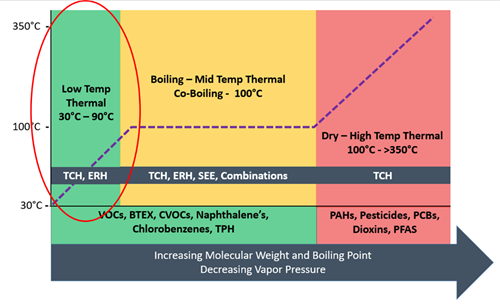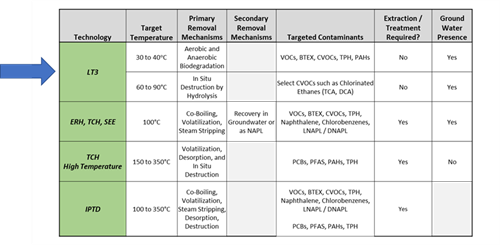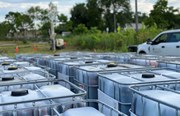Thermal technology is definitely one of the heavy hitters in the remediation world. It has the power to treat hard-to-remediate contaminants by the strategic application of energy—it’s impressive, to say the least. But the downside of thermal technology has always been how much energy it uses to do the job. As we seek to remediate, it also makes sense to keep our project as sustainable as possible so we don’t create harm while doing good. Although “sustainable” and “thermal remediation” are terms rarely seen together, today’s blog post explains how low temperature thermal treatment (LT3) can meet that definition while still achieving your project’s remediation goals.
If you’d like a deeper dive and the chance to ask questions, join us next week when we host a webinar titled Low Temperature Thermal: The Sustainable Approach. We will dive into the technology, detail the situations where low temperature thermal may be optimal, provide a comparison between low temp and high temp remediation, and discuss the costs and timeframes you can expect when using this technology.
HOW DOES LOW TEMPERATURE THERMAL TECHNOLOGY WORK?
Low temperature thermal technology gently heats the target treatment volume to temperatures between 30 and 90°C, with the goal of enhancing biological and abiotic contaminant degradation mechanisms. Since chemical reactions are temperature dependent, elevating the temperature will lead to increased reaction rates and, in turn, rapid removal of contaminants and reduced time to site closure.
Small diameter heaters are installed in a regular pattern, with the spacing is dependent on several factors, including the target treatment temperature, the depth interval of the treatment, rate of groundwater flux, and the project schedule. Once installed, heat is uniformly transferred from the heater directly to the soil through thermal conduction.
WHEN SHOULD LOW TEMPERATURE THERMAL TECHNOLOGY BE USED?
LT3 can be used in the following scenarios with positive results:
- When aerobic and anerobic biodegradation is the remediation pathway of interest: By increasing the treatment volume to a temperature between 30 and 40°C, biological reaction rates may be increased by three to four times which, in turn, can reduce biologically mediated cleanup times by a similar factor.
- If an abiotic pathway, such as hydrolysis, is the remediation pathway of interest: Increasing the treatment volume temperature between 60 and 90°C can substantially increase the abiotic reaction rate. For example, carbon tetrachloride has a hydrolysis half-life, at 15°C, of ~20,000 years but increasing the temperature to 90°C will reduce the hydrolysis half-life to ~100 days!
WHY CHOOSE LT3?
Because it uses less energy at every stage, LT3 technology is not only more sustainable than traditional thermal remediation, it’s also less costly. Installation of the low-cost (but robust!) electric powered heaters and well materials can be done using direct push methods. Once installed, the LT3 heaters provide constant and adjustable power input. Heating can take place 24/7, which will likely result in faster and more uniform heat-up of the treatment volume and ultimately increase its effectiveness.
Use of renewable energy sources, such as solar or wind, can help make the project even more sustainable. Additionally, the heaters, electrical cables, and other equipment employed in LT3 implementation are reusable, which reduces the carbon footprint—something traditional thermal remediation technologies cannot claim. And importantly, LT3 can be installed in an unobtrusive manner and be operated in the background, allowing full use of a property or facility.
Low temperature thermal technology can also be used in tandem with other remediation approaches, like in situ chemical oxidation (ISCO) and in situ chemical reduction (ISCR). By gently heating the treatment volume, the reaction rates of injectants, much like biological and abiotic degradation, may be increased. This can ultimately lead to increased efficiency of injection remediation and reduced cleanup timelines, thus decreasing project costs.

Low temperature thermal technology will not work for every remediation goal, but if an aerobic or anaerobic degradation pathway is being considered to target volatile organic compounds (VOCs), crude oil compounds (BTEX), chlorinated VOCs (CVOCs), total petroleum hydrocarbons (TPH), or polycylic aromatic hydrocarbons (PAHs), increasing the treatment temperature to between 30 and 40°C may be advantageous. Similarly, if select CVOCs like chlorinated ethanes can be targeted using abiotic degradation, increasing the treatment temperature to 60 to 90°C using LT3 may ultimately reduce the remediation timeline.

Low temperature thermal technology provides the means to make thermal remediation more sustainable and cost effective, while still meeting your remedial goals. If you are interested in learning more, we encourage you to join us for next week's webinar.
If you are unable to make it, register anyway and you will be emailed a link to the recording to watch later.
ABOUT THE AUTHORS

JOHN LACHANCE
Vice President, Technology
[email protected]
John LaChance is the Vice President of Technology at TerraTherm, a Cascade Company. In his 30+ year career in the remediation industry, he’s worked on a range of project sites, including chemical manufacturing plants, gas stations, oil refineries, railroads, former MGP sites, solvent recycling facilities, grain and feed storage centers, and landfills. Most of these sites have focused on the assessment and cleanup of chlorinated solvents and other recalcitrant chemicals.
Those projects have taken him all over the world, to sites in Brazil, China, Australia, and several European countries. As an international expert on in situ thermal remediation (ISTR), John has led the charge for the development of innovative heating technologies, including identifying sustainable energy and geothermal techniques that can optimize thermal remedies with a smaller environmental footprint.
In his current role, John helps clients select thermal technologies that will meet regulatory requirements, eliminate liability, and enable the resale or reuse of their property. Having designed and implemented more than 50 in situ thermal remedies addressing a range of contaminants, John brings a wealth of technical and strategic insight to every project. His clients can rely on him and his team to safely achieve remedial targets on budget and on schedule.

HILLARY EASTER
Data Manager
[email protected]
Hillary Easter is a Data Manager at TerraTherm, a Cascade Company. A chemist by training, she manages sampling logistics and laboratory analytical data as well as managing operation data and mass energy balance on thermal remediation projects.
Before joining TerraTherm in 2018, Hillary worked for seven years as an analytical chemist and lab quality assurance (QA) manager for a high-resolution site characterization (HRSC) mobile laboratory. As a mobile lab chemist, Hillary had the opportunity to travel both domestically and internationally to a wide variety of sites including former dry-cleaning facilities, Superfund sites, chemical manufacturing plants, as well as chemical storage facilities. She often draws on her years working both in the field and as a QA manager with a HRSC mobile lab in her role as a data manager and chemist with TerraTherm. In her spare time, Hillary teaches Organic Chemistry laboratory to students at a small state university in Vermont. She often uses her knowledge base in thermal remediation and analytical chemistry to inspire her students and encourage them that what they are learning in the classroom may very much apply later in their professional careers.

